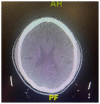A Case Report and Review: Charles Bonnet Syndrome Plus With Dementia
- PMID: 37426870
- PMCID: PMC10324678
- DOI: 10.36518/2689-0216.1303
A Case Report and Review: Charles Bonnet Syndrome Plus With Dementia
Abstract
Introduction: Charles Bonnet Syndrome (CBS) refers to visual hallucinations in visually impaired patients without psychiatric illness who are typically aware that their hallucinations are not real. Rare cases in the literature describe patients with atypical CBS, or CBS plus, who experience hallucinations in the context of sensory deficits but do not meet all of the criteria of a CBS diagnosis. These cases may include hallucinations in more than one sensory modality, including auditory hallucinations, which are thought to arise by a similar pathophysiology to that of the visual hallucinations in CBS. Unfortunately, the clinical criteria for atypical CBS are ambiguous, potentially explaining the rarity of the diagnosis. In addition, certain features of atypical CBS may make the condition particularly prone to misdiagnosis.
Case presentation: We report a case of atypical CBS in a 67-year-old white male patient presenting with visual and auditory hallucinations that were improved by reassurance. Alongside this case presentation, we provide a review of atypical CBS cases in the literature to compare the diverse features of the syndrome. For this review, we included cases of atypical CBS or CBS plus within the past 20 years for which we could obtain the full text.
Conclusion: Clearer guidelines for the diagnosis of atypical CBS and greater attention to the disorder could substantially improve the management of patients presenting with hallucinations. A broader differential diagnosis including atypical CBS for elderly patients with new-onset hallucinations could help clinicians and patients avoid unnecessary medical workup and treatment.
Keywords: Charles Bonnet Syndrome; Charles Bonnet Syndrome/diagnosis; Charles Bonnet Syndrome/diagnostic imaging; auditory hallucinations; diabetic retinopathy; hallucinations/etiology; hearing loss; perceptual disorders; visual hallucinations.
© 2022 HCA Physician Services, Inc. d/b/a Emerald Medical Education.
Conflict of interest statement
Conflicts of Interest The authors declare they have no conflicts of interest.
Figures
Similar articles
-
[Psychiatric, psychological comorbidities of typical and atypical Charles-Bonnet syndrome].Encephale. 2011 Dec;37(6):473-80. doi: 10.1016/j.encep.2011.05.006. Epub 2011 Jul 7. Encephale. 2011. PMID: 22137220 Review. French.
-
Ave Maria and Visions of Children: Atypical Charles Bonnet Syndrome or Two Coexisting Deafferentation Phenomena?Cureus. 2018 Aug 23;10(8):e3191. doi: 10.7759/cureus.3191. Cureus. 2018. PMID: 30402359 Free PMC article.
-
Multimodal Hallucinations in a Visually Impaired Elderly Female: Is it a Variant of Charles Bonnet Syndrome?Indian J Psychol Med. 2017 May-Jun;39(3):366-368. doi: 10.4103/0253-7176.207331. Indian J Psychol Med. 2017. PMID: 28615779 Free PMC article.
-
Charles Bonnet Syndrome.2023 Jul 25. In: StatPearls [Internet]. Treasure Island (FL): StatPearls Publishing; 2025 Jan–. 2023 Jul 25. In: StatPearls [Internet]. Treasure Island (FL): StatPearls Publishing; 2025 Jan–. PMID: 36256781 Free Books & Documents.
-
Charles Bonnet syndrome: case presentation and literature review.Optometry. 2009 Jul;80(7):360-6. doi: 10.1016/j.optm.2008.10.017. Optometry. 2009. PMID: 19545849 Review.
Cited by
-
Social Isolation as a Precipitating Factor for Charles Bonnet Syndrome in a Patient with Mild Visual Deterioration.Reports (MDPI). 2024 Aug 2;7(3):65. doi: 10.3390/reports7030065. Reports (MDPI). 2024. PMID: 40729288 Free PMC article.
References
Publication types
LinkOut - more resources
Full Text Sources
Miscellaneous

